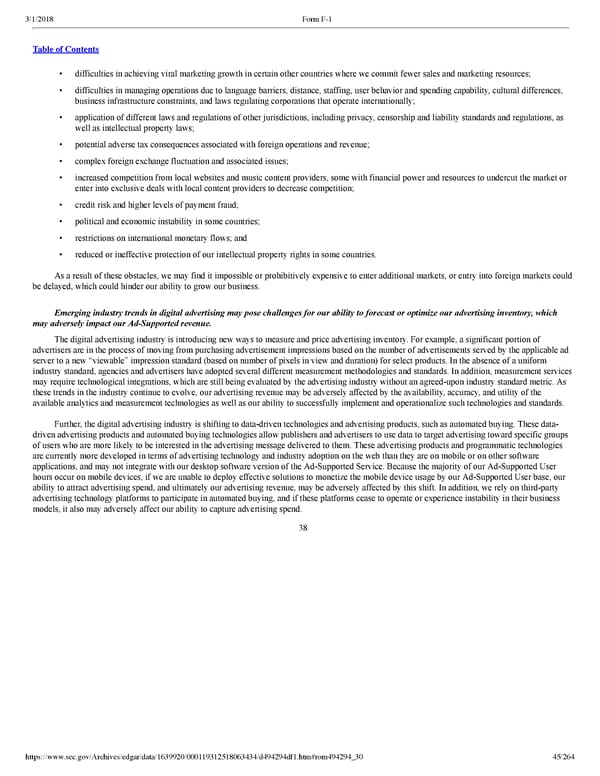45/264 • difficulties in achieving viral marketing growth in certain other countries where we commit fewer sales and marketing resources; • difficulties in managing operations due to language barriers, distance, staffing, user behavior and spending capability, cultural differences, business infrastructure constraints, and laws regulating corporations that operate internationally; • application of different laws and regulations of other jurisdictions, including privacy, censorship and liability standards and regulations, as well as intellectual property laws; • potential adverse tax consequences associated with foreign operations and revenue; • complex foreign exchange fluctuation and associated issues; • increased competition from local websites and music content providers, some with financial power and resources to undercut the market or enter into exclusive deals with local content providers to decrease competition; • credit risk and higher levels of payment fraud; • political and economic instability in some countries; • restrictions on international monetary flows; and • reduced or ineffective protection of our intellectual property rights in some countries. As a result of these obstacles, we may find it impossible or prohibitively expensive to enter additional markets, or entry into foreign markets could be delayed, which could hinder our ability to grow our business. Emerging industry trends in digital advertising may pose challenges for our ability to forecast or optimize our advertising inventory, which may adversely impact our AdSupported revenue. The digital advertising industry is introducing new ways to measure and price advertising inventory. For example, a significant portion of advertisers are in the process of moving from purchasing advertisement impressions based on the number of advertisements served by the applicable ad server to a new “viewable” impression standard (based on number of pixels in view and duration) for select products. In the absence of a uniform industry standard, agencies and advertisers have adopted several different measurement methodologies and standards. In addition, measurement services may require technological integrations, which are still being evaluated by the advertising industry without an agreedupon industry standard metric. As these trends in the industry continue to evolve, our advertising revenue may be adversely affected by the availability, accuracy, and utility of the available analytics and measurement technologies as well as our ability to successfully implement and operationalize such technologies and standards. Further, the digital advertising industry is shifting to datadriven technologies and advertising products, such as automated buying. These data driven advertising products and automated buying technologies allow publishers and advertisers to use data to target advertising toward specific groups of users who are more likely to be interested in the advertising message delivered to them. These advertising products and programmatic technologies are currently more developed in terms of advertising technology and industry adoption on the web than they are on mobile or on other software applications, and may not integrate with our desktop software version of the AdSupported Service. Because the majority of our AdSupported User hours occur on mobile devices, if we are unable to deploy effective solutions to monetize the mobile device usage by our AdSupported User base, our ability to attract advertising spend, and ultimately our advertising revenue, may be adversely affected by this shift. In addition, we rely on thirdparty advertising technology platforms to participate in automated buying, and if these platforms cease to operate or experience instability in their business models, it also may adversely affect our ability to capture advertising spend. 38
 Spotify F1 | Interactive Prospectus Page 44 Page 46
Spotify F1 | Interactive Prospectus Page 44 Page 46